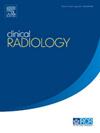Percutaneous electromagnetic navigation system for computed tomography (CT)-guided liver ablation: how far can we insert the antenna in the first scan?
IF 2.1
3区 医学
Q2 RADIOLOGY, NUCLEAR MEDICINE & MEDICAL IMAGING
引用次数: 0
Abstract
Aim
To evaluate technical/clinical success/efficacy of a commercially available electromagnetic navigation system in computed tomography (CT)-guided microwave ablation (MWA) of primary or metastatic liver tumours.
Materials and Methods
This prospective observational study evaluated tumours treated with percutaneous CT-guided MWA using a commercially available electromagnetic navigation system under intravenous analgesia. Technical parameters evaluated included procedural duration and ratio of inserted probe length in first/final control scan. Inserted needle lengths were measured from the skin surface to the antenna tip at firstand final control scan. Clinical success was defined as lack of tumour remnant in 1st-month imaging follow-up. The Cardiovascular and Interventional Radiological Society of Europe (CIRSE) classification system was used for complications' reporting.
Results
A total of 64 patients (66.25 ± 8.87 years) and 80 tumours (2.69 ± 1.10 cm) were included in the study. Technical success was 98.75%. The mean duration of the procedure was 47.63 ± 19.88 min. The mean ratio of inserted antenna length between first and final scan was 70.92% (±15.86). Primary clinical success was 96.25% (tumour remnant at one-month followup in 3/80 tumours; all three cases retreated with ablation). Secondary clinical success was 100% (no tumour remnant in imaging follow-up). Recorded complications were Grade 1 (4 self-limited perihepatic haematomas requiring nothing but observation) and Grade 3 (1 hepatic abscess treated with percutaneous drainage).
Conclusion
The use of an electromagnetic navigation system for CT-guided MWA of malignant liver lesions can permit insertion of >70% of the required microwave antenna length to target lesion in the first pass, with satisfactory technical and clinical success and low complication rate.
经皮电磁导航系统用于计算机断层扫描(CT)引导的肝脏消融:在第一次扫描中我们可以将天线插入多远?
目的评价市售电磁导航系统在计算机断层扫描(CT)引导微波消融(MWA)治疗原发性或转移性肝脏肿瘤中的技术/临床成功/疗效。材料和方法本前瞻性观察性研究评估了经皮ct引导MWA在静脉镇痛下使用市售电磁导航系统治疗的肿瘤。评估的技术参数包括程序持续时间和首次/最终控制扫描插入探针长度的比例。在第一次和最后一次对照扫描中测量从皮肤表面到天线尖端插入的针头长度。临床成功的定义是在第1个月的影像学随访中没有肿瘤残留。并发症的报告采用欧洲心血管与介入放射学会(CIRSE)分类系统。结果共纳入64例患者(66.25±8.87年),80个肿瘤(2.69±1.10 cm)。技术成功率为98.75%。手术平均持续时间为47.63±19.88 min,首次扫描与最终扫描的平均插入天线长度比为70.92%(±15.86)。初步临床成功率为96.25%(3/80例随访1个月肿瘤残留;3例均经消融术消退)。二次临床成功率为100%(影像学随访无肿瘤残留)。记录的并发症为1级(4例自限性肝周血肿,只需观察)和3级(1例肝脓肿经皮引流治疗)。结论采用电磁导航系统对肝脏恶性病变进行ct引导MWA,可第一次将所需微波天线长度的70%插入病灶,技术和临床成功,并发症发生率低。
本文章由计算机程序翻译,如有差异,请以英文原文为准。
求助全文
约1分钟内获得全文
求助全文
来源期刊

Clinical radiology
医学-核医学
CiteScore
4.70
自引率
3.80%
发文量
528
审稿时长
76 days
期刊介绍:
Clinical Radiology is published by Elsevier on behalf of The Royal College of Radiologists. Clinical Radiology is an International Journal bringing you original research, editorials and review articles on all aspects of diagnostic imaging, including:
• Computed tomography
• Magnetic resonance imaging
• Ultrasonography
• Digital radiology
• Interventional radiology
• Radiography
• Nuclear medicine
Papers on radiological protection, quality assurance, audit in radiology and matters relating to radiological training and education are also included. In addition, each issue contains correspondence, book reviews and notices of forthcoming events.
 求助内容:
求助内容: 应助结果提醒方式:
应助结果提醒方式:


